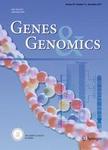版权所有:内蒙古大学图书馆 技术提供:维普资讯• 智图
内蒙古自治区呼和浩特市赛罕区大学西街235号 邮编: 010021

作者机构:Ganzhou Maternal & Child Hlth Hosp Ganzhou Jiangxi Peoples R China Fujian Med Univ Fujian Matern & Child Hlth Hosp Fujian Prov Key Lab Prenatal Diag & Birth Defect Med Genet Diag & Therapy CtrColl Clin Med Obstet Fuzhou Fujian Peoples R China Ganzhou Peoples Hosp Ganzhou Jiangxi Peoples R China Gothenburg Univ Dept Chem & Mol Biol Gothenburg Sweden
出 版 物:《GENES & GENOMICS》 (Genes Genomics)
年 卷 期:2025年第47卷第3期
页 面:293-305页
核心收录:
学科分类:0710[理学-生物学] 07[理学] 09[农学] 0836[工学-生物工程]
主 题:Nonsyndromic hearing loss CDH23 Autosomal recessive Whole-exome sequencing Noncanonical splice site variant
摘 要:Background Hearing loss adversely impacts language development, acquisition, and the social and cognitive maturation of affected children. The hearing loss etiology mainly includes genetic factors and environmental factors, of which the former account for about 50-60%. Objective This study aimed to investigate the genetic basis of autosomal recessive non-syndromic hearing loss (NSHL) by identifying and characterizing novel variants in the CDH23 gene. Furthermore, it seeks to determine the pathogenic potential of the noncanonical splice site variant c.2398-6G A. Methods Comprehensive clinical evaluation and whole-exome sequencing (WES) were performed on the girl. The WES analysis revealed two novel variants in the CDH23 gene, associated with nonsyndromic deafness 12 (DFNB12). To further explore the pathogenicity of these variants, functional studies involving in vivo splicing analysis were performed on the novel noncanonical splice site variant, c.2398-6G A, which was initially classified as a variant of uncertain significance (VUS). Results Whole-exome sequencing of the patient identified two compound heterozygous variants in CDH23: c.2398-6G A, a noncanonical splice site variant, and c.6068C A (p. Ser2023Ter), a nonsense mutation. In vitro splicing assays demonstrated that c.2398-6G A caused aberrant splicing, leading to a frameshift (p. Val800Alafs*6) and the production of a truncated protein, as confirmed by structural protein analysis. The study revealed novel mutations as likely pathogenic, linking both variants to autosomal recessive NSHL. Conclusions Our analyses revealed novel compound heterozygous mutations in CDH23 associated with autosomal recessive NSHL, thereby expanding the mutational landscape of CDH23-related hearing loss and increasing knowledge about the CDH23 splice site variants.